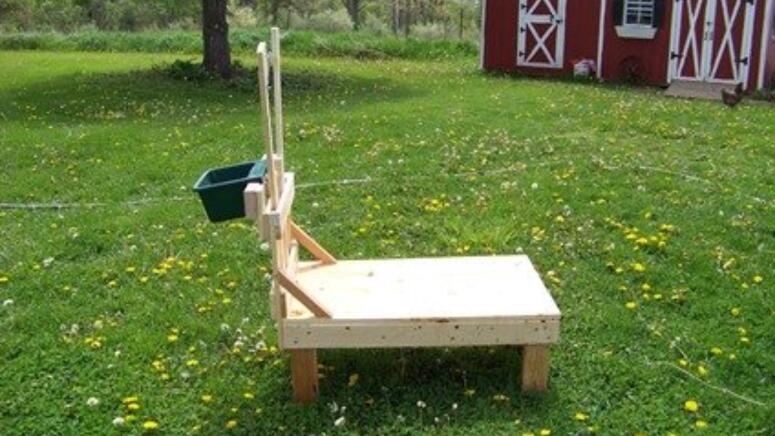Posted by Jennifer Sartell, Professional Homesteader & Blogger, Wed, Mar 18, 2015
Cleaning the Area
Clean the stall, removing all soiled bedding. Our stalls’ floors are made of cement, so we mop them with a diluted bleach solution and soapy water. We use a pine pelleted bedding to absorb any moisture and then apply a fresh, thick layer of clean straw.
Straw provides warmth, softness and comfort, and the pine adds a super-absorbent layer. It is important to protect kids from dampness and drafts.
Another great option for keeping your goats’ habitat fresh is Sweet PDZ®, the market’s leading stall refresher and odor neutralizer. Sweet PDZ absorbs and neutralizes ammonia and odors while providing safe, fresh air for your goats’ pen.
We also wash all buckets and feeding pails that the kids will be using. A good thorough cleaning is especially a good idea if you’ve experienced any illness in your herd.
Elements to Include
Throughout the year, we collect feed sacks and cut them open to form wide, clean rectangles of tarp-like material. They provide an instantly clean dry space. We always keep a stack of them close by around kidding time.
After our does have birthed, we provide them with a bucket of warm molasses water. Molasses contains iron and the sugar provides much-needed energy after a tough day of labor. Our does drain the bucket dry with gulping sucks and sigh in contented relief when the pail is empty.

The Importance of a Stanchion
A stanchion is an elevated stand with a place to gently secure the goat’s head/neck. It works to stabilize the goat, usually for milking purposes. A bucket is placed in front so the goat can munch on grain while they’re being milked. A great feeding option for your doe is Calf-Manna®. Calf-Manna provides high-quality proteins and energy, which are the building blocks for increased milk production.
A stanchion might not seem like something you need to prepare for the birth of baby goats. Many goat keepers decide to let the kids stay with their mother for several weeks, and the need to create a milking area isn’t a pressing issue.
We thought the same thing until our second doe gave birth.
Learn from our mistake!
The first doe that gave birth on our farm was a wonderful mother. She encouraged her healthy kid to stand, opened her leg and guided her to the teat to nurse. It was beautiful and easy.
Our second doe was not so easy. She gave birth and rejected her buckling. Every time he wobbled over to her to nurse, she flattened her ears and bolted to the other side of the pen. Her udders were becoming engorged with milk, and the little buckling was growing weaker and weaker chasing his mother around the pen. We stepped in and tried to help the two of them work things out, but the stubborn doe would have none of it.
We decided that the best thing to do was to milk the dam and bottle-feed it to the kid. This is where the second problem arose. We had no stanchion because we hadn’t planned on milking our goats for several weeks, as we wanted the kids to stay with their mother. We had nothing to keep the dam still while we milked her. She was exhausted from labor and anything but willing to be milked. She kicked and jumped every time we tried to get near her udders. She knocked over the bucket and spilled most of the colostrum that we were able to get out of her. Meanwhile the hungry kid bellowed for food. It was TERRIBLE!
In a perfect world, every goat gives birth, bonds with her kids and encourages them to nurse. The kid is healthy, strong, stands on its own, and latches easily, and all is well.
However, farm life is almost never perfect, so you must prepare to adapt. If you have a first-time mom, the chances of her rejecting her kid increases somewhat. Sometimes first-timers are clueless, especially if they were bottle-fed themselves as kids. There is also the possibility that the kid might not be strong enough to stand and nurse on their own. In both these cases, it’s important to get the dam milked.
We’ve since learned from our mistake and built a stanchion. We get our goats used to being on the stanchion at a very early age. We start preparing first-time dams ahead of time. We give her grain ration every day at the stanchion so that even though she’s not being milked, she will begin to think of it as a positive place. We handle her udders and train her to get used to that feeling. She might kick and fuss, but be firm; if she learns that by acting up, you give up, you are teaching her that that behavior pays off. Work in short sessions. By implementing this practice, we rarely have a doe that’s difficult to milk.
In addition to milking, our stanchion is a handy tool for keeping goats still while we carry out worming, vaccine administration, hoof trims and even shearing our Angora goats of their fiber. Our goats associate the stanchion with grain. It’s a happy place to which they go willingly. When we let our goats out of their pens, they often hop up on the stanchion just to check the bucket and see if there’s a treat inside.
Be sure to check out upcoming posts that cover how to prepare for birth, what supplies you might need and how to care for new arrivals!
Author Profile: Jennifer Sartell
Jennifer Sartell is the primary caretaker of all animals on her and her husband’s farm in Fenton, MI. With a passion for living a simple life, Jennifer enjoys creating art, taking in nature, raising animals and has developed a deep appreciation for homesteading. Jennifer and her husband, Zach, currently raise goats and poultry.
Her vast amount of experience on the farm includes, but is not limited to: milking, shearing, hoof trimming, vaccine administration, assisting in animal births, dehorning, egg collecting, chick and turkey hatching, feeding, watering, etc. She can also cook a mean farm-to-table meal and when the day is done has documented and photographed their day on the farm.
More Blogs by Jennifer Sartell
- https://www.mannapro.com/homestead/caring-for-pregnant-does-part-2
- https://www.mannapro.com/homestead/caring-for-pregnant-does-part-1
- https://www.mannapro.com/homestead/preparing-caring-for-goats-in-winter
- https://www.mannapro.com/homestead/dairygoatbreeds
- https://www.mannapro.com/homestead/preparing-the-kidding-stall-part-2
- https://www.mannapro.com/homestead/a-guide-to-buying-a-new-goat
- https://www.mannapro.com/homestead/raising-kids-dehorning-wethering
- https://www.mannapro.com/homestead/milking-a-goat
- https://www.mannapro.com/homestead/raising-fiber-goats-101
- https://www.mannapro.com/homestead/hoof-care-for-goats
- https://www.mannapro.com/homestead/putting-together-a-goat-birthing-kit
- https://www.mannapro.com/homestead/preparing-the-kidding-stall-part-1
- https://www.mannapro.com/homestead/breaking-down-the-goat-diet
- https://www.mannapro.com/homestead/birthing-goat-kids
- https://www.mannapro.com/homestead/dealing-with-goat-scours
- https://www.mannapro.com/homestead/feeding-baking-soda-to-your-goats
- https://www.mannapro.com/homestead/pros-cons-and-facts-about-raising-turkeys
- https://www.mannapro.com/homestead/best-breeds-for-raising-chickens-with-children
- https://www.mannapro.com/homestead/a-guide-to-small-goat-breeds
Featured Products

